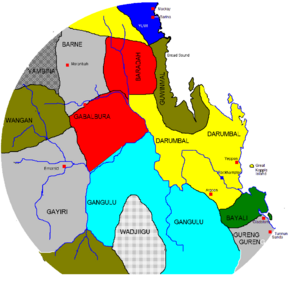Darumbal facts for kids
The Darumbal people are an Aboriginal Australian group who have lived for a very long time in Central Queensland. They traditionally spoke dialects of the Darumbal language. Some Darumbal people from the Keppel Islands and nearby areas are also known as Woppaburra or Ganumi. These names are sometimes used to mean the same group.
Contents
Darumbal Country
The traditional land of the Darumbal people covers about 4,000 square miles (10,000 square kilometers) along the coast of Central Queensland. This area stretches from Arthur Point at Shoalwater Bay to Yeppoon. It includes the mouth of the Fitzroy River and the beautiful Keppel Islands.
From Keppel Bay, their land reached inland to the Boomer Range and places like Marlborough, Yaamba, Rockhampton, and Gracemere.
A Look at Darumbal History
When European settlers arrived in the Darumbal region, the Darumbal people faced many challenges. They lost much of their land as new farms and towns were built. Sadly, during this time, many Darumbal people also lost their lives.
For example, between 1865 and 1902, the number of people living on the Keppel Islands dropped significantly. There were also tragic events, like one in July 1865 near Rockhampton. During a Darumbal ceremonial gathering, many Aboriginal people were killed. These events show the difficult times the Darumbal people experienced.
Darumbal Language
The Darumbal language is now classified as "extinct". This means that there are no longer any native speakers of the language. However, efforts are being made to bring it back. The Bayali language was different from Darumbal, sharing only a small number of words.
A common Darumbal greeting is Gudamulli, which means 'hello'.
Some Darumbal words are still used today in the names of places in Central Queensland. For instance, the town of Coowonga is named after a Darumbal man. He was famous for saving the life of a politician named King O'Malley a long time ago. The Rockhampton suburb of Nerimbera also has a Darumbal name. It means 'where the mountains meet the river'.
Darumbal Society
According to a researcher named Norman Tindale, the Darumbal people were made up of about 13 different groups or families. These groups lived and worked together in their traditional lands. One group, called the Warabal, may have lived near the Boomer Range.
Native Title and Recognition
In the 21st century, the Darumbal people began making claims for their native title rights. This is about recognising their traditional ownership of the land. In 2001, a claim was made to the National Native Title Tribunal. Later, in 2007, about 137 hectares (338 acres) of land at Mount Wheeler were given back to the Darumbal people. They have also been given limited access to the Shoalwater Bay Military Training Area.
In 2016, the Darumbal people were officially granted native title over their land. Then, in May 2022, they were recognised as the traditional custodians of a huge area of ocean. This area covers 36,606 square kilometers (14,134 square miles) off the Central Queensland Coast. This is the largest Traditional Use of Marine Resources Agreement (TUMRA) on the Great Barrier Reef. A special ceremony was held on the beach at Emu Park to celebrate this important event.
Recognised Ancestral Groups
Under the Darumbal Nation Native Title Claim, the descendants of the following family groups are officially recognised:
- Kitty Mulway and Pompey of Stannage – [Sunflower/Meredith]
- Kate Reid and James Hector – [Garret/Hector]
- Jack Naylor (Jnr); Brothers John McPherson and Harry Bauman – [Hatfield/McPherson/Naylor/Bauman (Bowman)]
- Clara Wallace – [Mann/Wallace/Williams/Hector/Edmunds]
- Clara McKenzie – [Rutherford/Hayden]
- Maggie (Mitchell); Mary Jones; Maria McKenzie; Mundabel – [Ross/Landers/Roma/Adams/Wylie/Fitzgerald]


